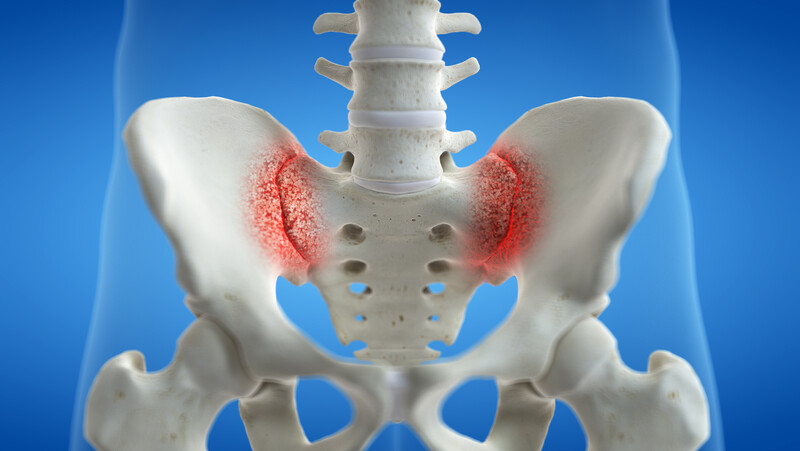Sacroiliac joint injury is a common complaint we see in our patients with chronic pain. For some, this is a recent development, the result of a fall or injury. For others, this is a problem that they have been struggling with for years, trying various treatments that provide little or no long-term relief. Some come into our office after an examination by a spinal surgeon who have given them a recommendation to surgery. Many people consider the surgery because their problem has been getting progressively worse.
Most patients that seek non-surgical treatment of their lower back pain come to us as a last chance effort to avoid surgery. They have tried nearly every other treatment and have exhausted all possibilities – chiropractic, acupuncture, epidural steroid injections, physical therapy, massage, and a litany of medications such as anti-inflammatories, Lyrica, Neurontin, anti-depressants, muscle relaxers, and others.
Treatment for sacroiliac joint pain should not include sacroiliac fusion?
Should you consider surgery, there is evidence to suggest that some people will have successful surgeries and some people will not have successful surgeries.
This is what a paper published in the July 2017 edition of Neurosurgery clinics of North America (1) suggested about Sacroiliac Fusion:
“Pain related to joint dysfunction can be treated with joint fusion; this is a long-standing principle of musculoskeletal surgery. However, pain arising from the sacroiliac joint is difficult to diagnose. Several implant devices are available that promote fusion by simply crossing the joint space. Evidence establishing outcomes is misleading because of vague diagnostic criteria, flawed methodology, bias, and limited follow-up. Because of non-standardized indications and historically inferior reconstruction techniques, sacroiliac joint fusion should be considered unproven. The indications and procedure in their present form are unlikely to stand up to scrutiny or weather the test of time.”
A 2019 study suggests:(2)
“The rationale for SI joint fusion is to relieve pain created by the movement of a joint through the removal of movement by arthrodesis (fusion) of the joint space. Only few comparative studies of percutaneous SI joint fusion and denervation have been reported, and they had limited clinical evidence.. The safety and effectiveness of percutaneous fusion compared with denervation remained inconclusive. However, surgical fusion with a percutaneous SI screw placement might have a higher rate of complications than Radiofrequency neurotomy. (A radio wave treatment that temporarily blocks pain signals).”
There are many studies which also suggest that a patient can do very well with this type of surgery. These are newer studies on newer surgical techniques. But surgery is still surgery and a December 2019 asks: “What do we know about the biomechanics of the sacroiliac joint and of sacropelvic fixation?” (3)
In this study, doctors offer this opinion on newer surgical techniques:
“The sacroiliac joint is characterized by a large variability of shape and ranges of motion among individuals. Although the ligament network and the anatomical features strongly limit the joint movements, sacroiliac displacements and rotations are not negligible (instability of the SI joint should not be overlooked).
Currently available treatments for sacroiliac joint dysfunction include physical therapy, steroid injections, Radio-frequency ablation of specific neural structures, and open or minimally invasive SIJ fusion.
Several studies reported the clinical outcomes of the different (surgical) techniques and investigated the biomechanical stability of the relative construct (the fusion), but the effect of sacropelvic fixation techniques on the joint flexibility and on the stress generated into the bone is still unknown. In our opinion, more biomechanical analyses on the behavior of the sacroiliac joint may be performed in order to better predict the risk of failure or instability of the joint.”
As with any medical technique, including SI joint fusion, there are good stories and there are not so good stories. The decision to go to surgery is a tough choice for many people.
If you suffer from unresolved sacroiliac joint pain there can be a non-surgical option
Researchers writing in the medical journal Pain Physician (4) examined various treatment recommendations for patients suffering from sacroiliac joint pain to confirm what many of our patients know. Many traditional non-surgical treatments do not provide short or long-term relief and this failure of treatment makes surgery a more attractive and realistic option.
The researchers found the following:
“The evidence for cooled radiofrequency neurotomy in managing sacroiliac joint pain is fair.
The evidence for effectiveness of intraarticular steroid injections is poor.
The evidence for periarticular injections of local anesthetic and steroid or botulinum toxin is poor.
The evidence for effectiveness of conventional radiofrequency neurotomy is poor.
The evidence for pulsed radiofrequency is poor.”
Prolotherapy, PRP, and Regenerative Therapy Injections
So are there non-surgical options that may provide long-term relief?
For more than 30 years, the Magaziner Center has been leading the way in cutting-edge, non-surgical, regenerative medicine. This includes treatment of sacroiliac joint pain.
The procedures in which we specialize include:
Prolotherapy injections: A widely recognized orthopedic procedure that reconstructs joints, ligaments and tendons that have been weakened by trauma or arthritis.
Platelet-Rich Plasma (PRP) injections: A way to jump-start the body’s natural healing process by delivering a high concentration of platelets directly into an injured area.
Regenerative Therapies: We utilize a variety of innovative therapies to help repair damaged tissue and restore normal cellular function.
The research:
A report in the Journal of Alternative and Complementary Medicine (5) says: “Intra-articular Prolotherapy provided significant relief of sacroiliac joint pain, and its effects lasted longer than those of steroid injections.
A separate study also reported in the Journal of Alternative and Complementary Medicine says: “Ninety-one percent (91.0%) of (Prolotherapy) patients reported a reduction in the level of pain; 84.8% of patients reported improvement in activities of daily living, and 84.3% reported an improvement in the ability to work.”(6)
Prolotherapy worked because all the ligament and tendon structures that hold this joint together can become stressed, strained, or torn but may appear normal on MRI. Research published in the medical journal Spine, states “ligament laxity in the sacroiliac joint is the number one reason for sciatica, or pain radiating down the side of the leg, and is one of the most common reasons for chronic low back pain.” (7)
Not only has research shown Prolotherapy to be effective but PRP as well. In a study from July 2017 in the journal Pain Practice, doctors suggest that “Despite widespread use of steroids to treat sacroiliac joint pain, their duration of pain reduction is short. Platelet-rich plasma (PRP) can potentially enhance tissue healing and may have a longer-lasting effect on pain.” In fact, this research showed clear superiority in the PRP treatment over steroid injection in significantly reducing the intensity of pain.”(8)
A 2019 study in the journal Pain Physician (9) made the following guideline recommendations
There is good evidence for sacroiliac joint injections of PRP.
“Regenerative therapy should be provided to patients following diagnostic evidence of a need for biologic therapy, following a thorough discussion of the patient’s needs and expectations, after properly educating the patient on the use and administration of biologics and in full light of the patient’s medical history.”
“Regenerative therapy may be provided independently or in conjunction with other modalities of treatment including a structured exercise program, physical therapy, behavioral therapy, and along with the appropriate conventional medical therapy as necessary.”
Sacroiliac joint pain relief
Sacroiliac joint pain relief can be challenging. There are “no magic bullets.” A realistic treatment program offered by experienced physicians may be your way to go. If you would like to explore your options with us, please contact our office so we can start a conversation with you.
Related articles:
Low Back Pain Patients Are Dissatisfied With Their Medical Care
Epidural Spinal Injections – Will They Help You?
References
1 Bina RW, Hurlbert RJ. Sacroiliac Fusion: Another “Magic Bullet” Destined for Disrepute. Neurosurgery Clinics of North America. 2017 Jul 31;28(3):313-20.
2 Chuang CW, Hung SK, Pan PT, Kao MC. Diagnosis and interventional pain management options for sacroiliac joint pain. Ci Ji Yi Xue Za Zhi. 2019 Sep 16;31(4):207-210. doi: 10.4103/tcmj.tcmj_54_19. PMID: 31867247; PMCID: PMC6905244.
3 Casaroli G, Bassani T, Brayda-Bruno M, Luca A, Galbusera F. What do we know about the biomechanics of the sacroiliac joint and of sacropelvic fixation? A literature review. Medical Engineering & Physics. 2019 Dec 19.
4 Hansen H, Manchikanti L, Simopoulos TT, et al. A systematic evaluation of the therapeutic effectiveness of sacroiliac joint interventions. Pain Physician. 2012 May;15(3):E247-78.
5. Kim WM, Lee HG, Jeong CW, Kim CM, Yoon MH. A randomized controlled trial of intra-articular prolotherapy versus steroid injection for sacroiliac joint pain. J Altern Complement Med. 2010 Dec;16(12):1285-90.
6 Hooper RA, Ding M.Retrospective case series on patients with chronic spinal pain treated with dextrose prolotherapy.J Altern Complement Med. 2004 Aug;10(4):670-4.
7 Schwarzer AC, April CN, Bogduk N. The sacroiliac joint in chronic low back pain. Spine 1995;20:31-37
8 Singla V, Batra YK, Bharti N, Goni VG, Marwaha N. Steroid versus Platelet-Rich Plasma in Ultrasound-Guided Sacroiliac Joint Injection for Chronic Low Back Pain. Pain Pract. 2016 Sep 27. Pain Pract. 2017 Jul;17(6):782-791. doi: 10.1111/papr.12526. Epub 2016 Dec 1.
9 Navani A, Manchikanti L, Albers SL, Latchaw RE, Sanapati J, Kaye AD, Atluri S, Jordan S, Gupta A, Cedeno D, Vallejo A. Responsible, Safe, and Effective Use of Biologics in the Management of Low Back Pain: American Society of Interventional Pain Physicians (ASIPP) Guidelines. Pain physician. 2019 Jan 1;22(1):S1-74.





































Recent Comments